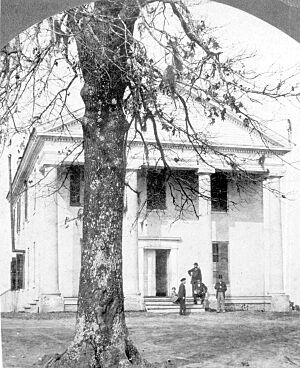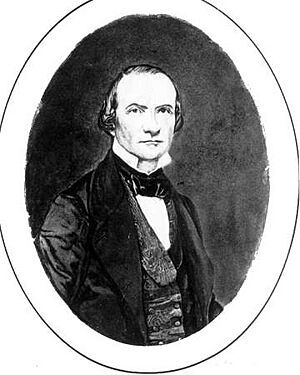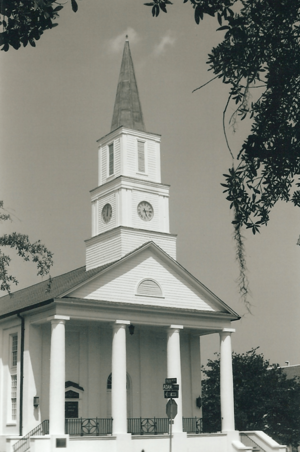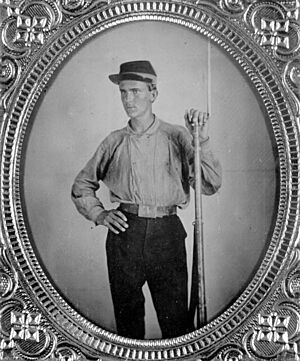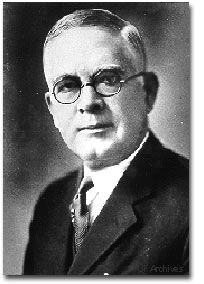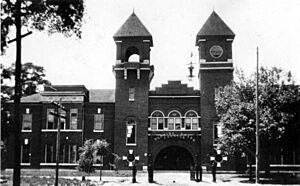History of Florida State University facts for kids
The history of Florida State University (FSU) goes back to the 1800s. It is closely connected to the story of education in Florida and in the city of Tallahassee.
Florida State University, often called Florida State or FSU, is one of the oldest and largest schools in Florida's state university system. Its beginnings can be traced to the West Florida Seminary. This was one of two state-funded schools that the Florida Legislature decided to create in 1851.
The West Florida Seminary, also known as the Florida State Seminary, opened in Tallahassee in 1857. It took over the Florida Institute, which had been set up to help Tallahassee get the seminary. The old Florida Institute land, where the historic Westcott Building now stands, is the oldest place in Florida that has been used continuously for higher education. This area, just west of the state Capitol, was once called Gallows Hill. It was a place for public executions in early Tallahassee. In 1858, the seminary also took in the Tallahassee Female Academy, which started in 1843. This made the school open to both boys and girls.
In 1863, during the American Civil War, Florida's Confederate government added a military school. They changed the name to the Florida Military and Collegiate Institute. Students from the school formed a military unit. They helped stop a Union attack on Tallahassee at the Battle of Natural Bridge. In 1883, the school became part of the Florida University. This was the first state-supported university founded in Florida. The university idea did not get much support from lawmakers. So, the seminary soon went back to its old name. However, it focused more and more on modern high school education.
In 1905, the Buckman Act changed higher education in Florida. The school was reorganized as a college for white women, called the Florida State College for Women. After World War II, the school became open to both genders again. This helped many students who were going to college using the G.I. Bill. It was then renamed Florida State University. The university became racially integrated in 1963. It was known as a place for student activism during the 1960s. Through the 1900s and 2000s, Florida State University has grown in size and academic importance. It has focused especially on advanced research.
Contents
Starting the University
In 1823, the United States Congress decided that the Florida Territory should have two learning seminaries. One would be on each side of the Suwannee River. By 1838, Florida's first constitution promised a system of general education (schools) and higher education (seminaries).
Throughout Tallahassee's history, leaders from the First Presbyterian Church, Tallahassee helped push for education. This church is near Florida State University. The First Presbyterian Church building was built before 1838. It is the oldest public building in Tallahassee. For almost 100 years, this church had a strong connection with the start and growth of what is now Florida State University.
Early Schools in Tallahassee
Tallahassee city leaders started a school for boys called the Leon Academy in 1827. It was run by Presbyterian Rev. Henry M. White. By 1831, the Tallahassee City Council controlled the Leon Academy.
The Leon Academy struggled with money problems and changes in leadership. By 1840, it stopped being a public school. However, the city's leading citizens still wanted good schools.
Florida Institute and West Florida Seminary
The Leon Academy was replaced by schools for boys and girls. These were set up by Reverend Joshua Phelps and Elder David C. Wilson, both from the First Presbyterian Church. In 1846, these schools merged into a new Leon Academy for Males and Females. This later split into the Tallahassee Female Academy for girls.
On January 24, 1851, the Florida Legislature voted to create the West Florida Seminary (which became FSU) and the East Florida Seminary (which became the University of Florida). This law set up how the schools would be run. However, it did not decide where they would be located. This decision was left to the towns that offered the best support.
Three towns wanted the West Florida Seminary: Tallahassee, Marianna, and Quincy. The competition was tough. To help its chances, the City Council of Tallahassee built and funded an all-male school called the Florida Institute. This was a new version of the Leon Academy from 1827.
In 1854, the Tallahassee City Council offered $10,000 for a new school building. They hoped this would help Tallahassee become the home of the western seminary. Construction on the Florida Institute building began in 1854. It was finished in April 1855 and cost $6,172. It was considered the "handsomest building in Tallahassee." About 100 students enrolled in 1855-1856.
By 1856, Tallahassee won the bid to host the seminary. The Florida Institute became the West Florida Seminary. The land where the Florida Institute stood, slightly west of Tallahassee's center, was accepted as the site for the western state seminary for male students. The seminary officially started state classes in 1857. In 1858, it took in the Tallahassee Female Academy, making it open to both boys and girls. This site is the oldest place in Florida continuously used for higher learning.
War and Changes
During the American Civil War, the seminary's name changed to The Florida Military and Collegiate Institute. It began military training for students. Young cadets from the school, along with other soldiers, helped defeat Union forces at the Battle of Natural Bridge in 1865. Tallahassee was the only Confederate capital east of the Mississippi River that did not fall to Union forces.
The Army Reserve Officers' Training Corps (ROTC) unit at Florida State University is special. It is one of only four ROTC units in the U.S. allowed to display a special flag called a campaign streamer. This streamer says "NATURAL BRIDGE 1865." After the war, the West Florida Seminary went back to being a purely academic school. It then began to grow a lot.
Florida's First State University (1883-1901)
In 1883, the West Florida Seminary became part of Florida University. This was Florida's first state-supported university. The seminary became the university's Literary College. It offered different subjects. However, the seminary kept its own special rules.
The Florida Legislature recognized the university in 1885. But it did not give any extra money. Without lawmaker support, the university project struggled. The medical college that was part of it moved away. The law department also closed. By 1891, the school had a four-year program. The first graduation under the name Florida State University happened in 1891. The Tallahassee school never actually used the "University of Florida" name.
The West Florida Seminary continued to grow. It focused more on modern higher education. It started giving out its first diplomas in 1884. It gave out Bachelor of Arts degrees in 1891. By 1897, it had become Florida's first liberal arts college.
Florida State College (1901–1905)
In 1901, the Seminary was reorganized into the Florida State College. It had four main parts: the College, the College Academy, the School for Teachers, and the School of Music. Its goal was to be a top school in the South. In 1901–1902, there were almost 300 students from many parts of Florida and other states. It offered different types of degrees. The college also had sports teams, including track, baseball, football, and a women's basketball team.
Florida State College for Women (1905–1947)
The 1905 Buckman Act changed Florida's colleges. It grouped the six existing colleges into three schools. These schools were separated by "race" and gender. There was a school for white males (University of Florida), a school for white females (Florida Female College), and a school for both African American males and females (State Normal School for Colored Students). By 1909, the school for white females was renamed the Florida State College for Women.
Under the Buckman Act, the State Normal School for Colored Students (now Florida A&M University) became the college for African Americans. The other four schools for white males were combined into the University of the State of Florida in Gainesville. This law was much debated. It limited opportunities for public higher education in Florida. It also set up different goals for men's and women's education. Men's education was about "citizenship," while women's education was about "usefulness."
Despite these changes, Albert A. Murphree, who was President of Florida State College, focused on strong academic programs. Florida State was the largest of the two main universities in Florida until 1919. Even as a college for women (from 1905 to 1947), it grew a lot. By 1933, the Florida State College for Women was the third largest women's college in the United States. In 1935, it became the first state women's college in the South to get a chapter of Phi Beta Kappa. This is a very respected academic honor society. It was also the first university in Florida to receive this honor.
After World War II (1945-1960)
After World War II, many soldiers came home and wanted to go to college using the new G.I. Bill. This created a huge demand for college spots. So, the Tallahassee Branch of the University of Florida (TBUF) quickly opened on the campus of the Florida State College for Women. The men lived in old barracks at Dale Mabry Field, a former WWII air force training base. They traveled to the main campus by bus. This area was briefly known as "West Campus." By 1947, the Florida Legislature made the FSCW open to both genders again. It was renamed Florida State University. The FSU West Campus land later became the location of the Tallahassee Community College.
The 1950s brought much growth to the university. Several new colleges were added. The first advanced degree (Ph.D.) was given in Chemistry by 1952. Many buildings that are still used today were added. These include the Strozier Library, Tully Gymnasium, and parts of the Business building. New programs were added, like Business, Library Science, Nursing, and Social Welfare.
School Songs
In 1947, the school newspaper held a contest for a school song. "High O'er the Towering Pines" won and became the official alma mater in 1949.
"The Hymn to the Garnet and the Gold" was first performed in 1950. It became a Homecoming tradition.
The "FSU Fight Song" was first performed in 1950. A student wrote the lyrics as a poem. A music professor saw the poem and wrote a tune for it. The Fight Song is now one of the most recognized college songs in the country. In 1983, Mission Control even used it to wake up a former FSU student, Norm Thagard, who was an astronaut on the Space Shuttle Challenger.
Student Action and Integration
During the 1960s and 1970s, Florida State University was known for student activism. Students spoke out about racial integration, women's rights, and the Vietnam War. The school was sometimes called 'Berkeley of the South' because of similar student activities at the University of California, Berkeley.
After many years as a segregated university, and partly due to student efforts, Maxwell Courtney became the first African American undergraduate student admitted to Florida State in 1962. In 1968, Calvin Patterson became the first African American player for the Florida State University football team.
Tallahassee and Florida State were challenging places for African Americans even in 1968. When Calvin Patterson joined the Florida State Seminoles, he faced insults and threats. Tallahassee was still very much like the "Old South." Patterson was not fully accepted by many white students and fans at FSU. Some black students at nearby Florida Agricultural and Mechanical University also saw him as a "traitor."
A 2017 study found that Florida State University was among the top 20 colleges in the country for graduation rates among African-American students. About 75% of African-American students at FSU graduate within six years. This is much higher than the national average.
Campus Safety Incident (2014)
On November 20, 2014, an incident occurred at Strozier Library on the university campus. An individual shot an employee and two students. Police officers responded and the individual was fatally shot after firing at them. After the incident, it was found that the individual had sent packages to friends beforehand. The university focused on supporting its community and ensuring safety.
See also
- Burning Spear Society
- Florida State Seminoles
- History of Florida
- List of Florida State University people
- List of presidents of Florida State University


